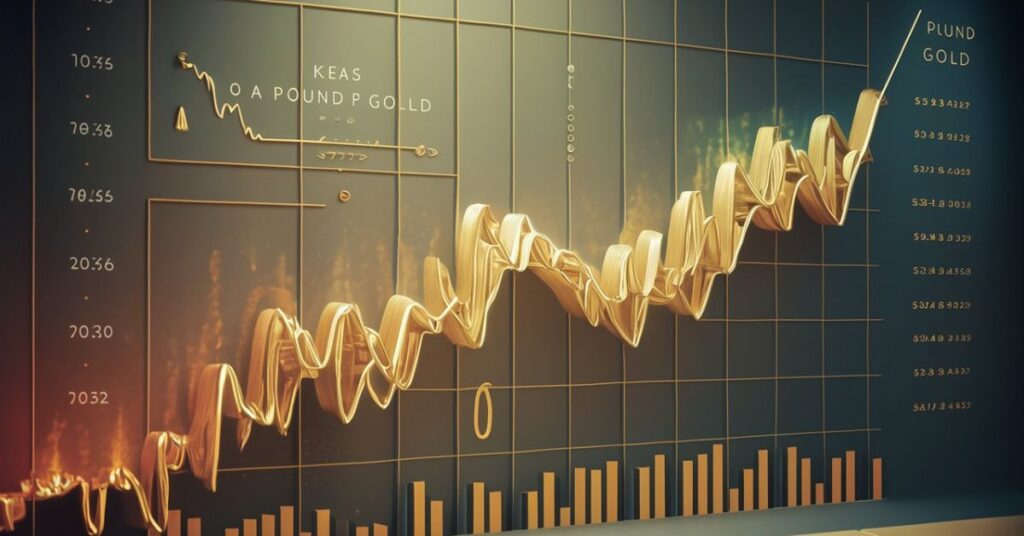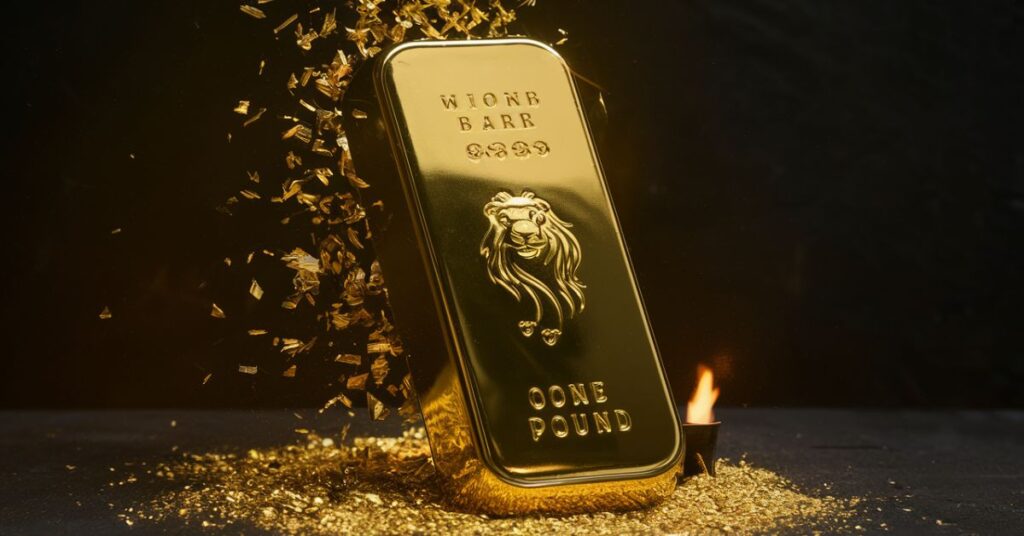In simple terms, the price of gold per pound fluctuates based on several factors like economic conditions and market demand. Gold is measured in troy ounces, with 12 troy ounces making up a pound. Currently, the spot price of gold is $1,853.98 per troy ounce, making a pound of gold worth $22,247.76. This value can change rapidly due to shifts in the global economy and geopolitical events.
Discover the hidden treasure of gold’s value! Dive into the enchanting realm of gold prices per pound of gold worth. Unravel the mysteries behind the fluctuating worth of this precious metal. Explore the historical trends and economic factors shaping its value. Delve into the world of gold investment and seize the opportunity to secure your financial future. Join us on a journey to uncover the secrets of gold’s cost per pound!
In recent years, the value of a pound of gold worth has fluctuated significantly, influenced by factors such as economic stability, inflation rates, and geopolitical tensions. Tracking historical data reveals how gold’s worth has evolved, with the pound of gold worth three times its previous value in some instances. Investors often analyze these trends to make informed decisions about their investments.
How Much Was a Pound of Gold Worth in Recent Years?
In recent years, the value of pound of gold worth per pound has experienced fluctuations driven by various economic factors. From 2009 to 2011, the price of gold surged, reaching a peak of around $2,300 per troy ounce. This increase was largely attributed to the 2008 recession and a weakened U.S. dollar.
However, in 2012, gold prices stabilized, hovering around $2,100 per troy ounce due to lower interest rates and increased investment in precious metals. The following year, 2013, saw a significant drop in gold prices as inflation receded and long-term interest rates rose. This decline continued into 2014, reaching a low point in 2015.

Despite fluctuations, the value of gold has remained an attractive investment option. Investors often view gold as a hedge against economic instability and inflation, making it a valuable asset in diversified portfolios. As of 2023, gold prices continue to evolve in response to global economic shifts and geopolitical tensions, reflecting its enduring role as a store of value and safe-haven asset.
Gold Price From 2009-2011
Between 2009 and 2011, the price of gold experienced significant fluctuations, reflecting economic uncertainty and market volatility. Starting around $1,300 per troy ounce in 2009, gold prices soared to approximately $2,300 per troy ounce by late 2011. This surge was largely driven by the aftermath of the 2008 recession, as investors sought the security of gold amidst a weakened U.S. dollar.
The period also witnessed a notable increase in the Producer Price Index, indicating a surge in the spot price of gold. Economic turmoil prompted individuals and institutions to turn to gold as a safe-haven asset, driving its value to historic highs.
The price surge in gold during this period underscored its role as a reliable store of value during times of economic instability. This upward trend in gold prices from 2009 to 2011 highlighted the metal’s appeal as a hedge against inflation and currency depreciation. The period marked a significant shift in investor sentiment towards precious metals, with gold emerging as a favored investment option.
Price of a Troy Ounce of Gold From 2012-2013
From 2012 to 2013, the price of a troy ounce of gold remained relatively stable, following a period of significant volatility. Despite reaching an all-time high in late 2011, gold prices began to stabilize in 2012, hovering around $2,100 per troy ounce.
Lower interest rates during this time encouraged increased investment in gold and other precious metals, sustaining demand and supporting prices. However, 2013 saw a notable downturn in gold prices as economic conditions improved and inflation receded. Rising long-term interest rates further contributed to the decline in gold prices during this period.
Factors such as reduced demand for gold as a hedge against inflation and higher interest rates led to a decrease in its market value. Despite fluctuations, gold remained an attractive investment option for those seeking stability in times of economic uncertainty.
The stabilization of gold prices from 2012 to 2013 reflected a period of relative calm in global financial markets. Investors closely monitored economic indicators and central bank policies for signs of potential market shifts.
Overall, the price movements during this period underscored the importance of monitoring economic trends and geopolitical developments when investing in precious metals.
Read This Blog: Miguel Gallego Arámbula Age, Height, Biography, Net Worth, Career, Parents, Siblings
Gold Spot Price From 2013-2019
From 2013 to 2019, the gold spot price experienced fluctuations driven by various economic factors. The price of gold per troy ounce declined initially in 2013 and 2014, reaching a significant low point in 2015.
Economic instability and a weakened U.S. dollar contributed to this decline in gold prices. However, the market saw a gradual increase in gold prices starting in 2018. In 2019, economic shifts and geopolitical conflicts led to a substantial rise in gold’s value, with prices climbing over $1,300 per ounce in June.
These price movements reflected investors’ responses to changing economic conditions and geopolitical tensions worldwide. Despite fluctuations, gold remained a popular investment choice for those seeking to hedge against economic uncertainty.
The upward trend in gold prices in 2019 highlighted its role as a safe-haven asset during times of financial turmoil. Investors closely monitored global economic indicators to gauge the direction of gold prices and make informed investment decisions. Throughout this period, gold continued to be viewed as a store of value and a reliable asset for portfolio diversification.
Gold Price Per Troy Ounce From 2020-2023
From 2020 to 2023, the gold price per troy ounce experienced dynamic fluctuations in response to global economic events. The onset of the COVID-19 pandemic in 2020 led to heightened market volatility and increased demand for gold as a safe-haven asset. Early 2020 saw troy ounces of gold priced around $1,800 amid financial uncertainties.
However, gold prices gradually decreased as economic conditions stabilized. Experts predict that gold prices will rebound by mid-to-late 2023 due to ongoing economic recovery efforts and geopolitical tensions. Investors closely monitor gold prices as an indicator of economic health and market sentiment.
The fluctuating gold prices during this period underscored its role as a hedge against inflation and market volatility. Understanding the factors influencing gold prices is crucial for informed investment decisions.
Gold’s intrinsic value and historical stability make it a popular choice for portfolio diversification. As economic conditions evolve, gold remains a reliable asset for preserving wealth and mitigating risks.
How the Price of Precious Metals Correlates With Other Investments
Understanding how the price of precious metals correlates with other investments is crucial for diversifying investment portfolios. Generally, precious metals like gold have an inverse relationship with the stock market.
When stocks perform positively, gold prices tend to decrease, and vice versa. Bonds, known as safe-haven assets, often have a positive correlation with gold prices. Real estate and gold prices typically do not exhibit a significant correlation.
The correlation between gold and cryptocurrency remains uncertain due to the relatively recent emergence of digital currencies. Gold’s perceived value as a hedge against inflation influences its correlation with economic factors. Investors often turn to gold during times of economic uncertainty to safeguard their wealth.
By evaluating correlations between precious metals and other assets, investors can make informed decisions to mitigate risks and optimize returns. It’s essential to monitor market trends and economic indicators to understand these correlations accurately. Diversifying investments across various asset classes, including precious metals, helps manage portfolio volatility and achieve long-term financial goals.
Stocks
Stocks represent ownership in a company and are traded on stock exchanges globally. Investing in stocks can provide significant returns over time, but it also involves risks. The stock market’s performance can fluctuate based on various factors, including economic conditions, corporate earnings, and geopolitical events.
Investors often diversify their portfolios by investing in a mix of stocks from different industries and sectors. Understanding the fundamentals of a company, such as its financial health and growth potential, is crucial before investing in its stock. Long-term investors may benefit from the power of compounding and the growth potential of stocks.

However, short-term traders may capitalize on market volatility and price fluctuations to generate profits. It’s essential to conduct thorough research and analysis before making any stock investment decisions. Monitoring market trends and staying informed about economic developments can help investors make informed choices.
Additionally, seeking guidance from financial advisors or utilizing investment tools can enhance investment strategies. Investing in stocks requires patience, discipline, and a long-term perspective to withstand market fluctuations. By staying focused on investment goals and maintaining a diversified portfolio, investors can potentially build wealth over time.
Bonds
Bonds are debt securities issued by governments, municipalities, or corporations to raise capital. Investing in bonds entails lending money to the issuer in exchange for periodic interest payments and the return of the principal amount upon maturity. Bonds are generally considered safer investments compared to stocks due to their fixed income and lower volatility.
Bond prices and interest rates have an inverse relationship: when interest rates rise, bond prices fall, and vice versa. Bonds can provide stable income streams, making them attractive to conservative investors seeking capital preservation. Government bonds, such as U.S. Treasury bonds, are often considered low-risk investments due to the backing of the government.
Corporate bonds offer higher yields but come with higher credit risk, depending on the issuer’s financial stability. Municipal bonds finance local government projects and may offer tax advantages for investors. Bonds can be purchased individually or through mutual funds, ETFs, or bond funds for diversification.
Investors should assess bond credit ratings, maturity dates, and interest rate sensitivity before investing. Bond prices can fluctuate based on market conditions and changes in interest rates, affecting overall portfolio performance. Diversifying bond investments across different issuers and maturities can help manage risk.
Bond investors should consider their investment objectives, risk tolerance, and time horizon before making investment decisions. Regularly reviewing bond portfolios and adjusting asset allocations based on changing market conditions is advisable. Seeking advice from financial professionals can help investors develop appropriate bond investment strategies.
Read This Blog: Nikocado Avocado Weight Loss 2024 Journey
Real Estate
Real estate refers to land, buildings, and natural resources such as minerals, water, and crops. Investing in real estate involves purchasing, owning, managing, renting, or selling properties for profit. Real estate is considered a tangible asset with the potential for long-term appreciation and income generation.
Residential real estate includes single-family homes, condominiums, apartments, and vacation properties. Commercial real estate encompasses retail spaces, office buildings, industrial properties, and hotels. Real estate investment trusts (REITs) allow investors to own shares in real estate portfolios without directly owning properties.

Real estate investments offer potential tax benefits such as deductions for mortgage interest, property taxes, and depreciation. Rental income from real estate properties can provide steady cash flow and passive income for investors.
Real estate values can be influenced by factors like location, economic conditions, supply and demand dynamics, and interest rates. Investing in real estate requires careful research, due diligence, and risk assessment to identify profitable opportunities. Fluctuations in real estate markets can affect property values, rental rates, and investment returns.
Diversifying real estate investments across different property types and geographic locations can mitigate risk. Real estate investment strategies may include fix-and-flip, buy-and-hold, rental property, and real estate development.
Real estate crowdfunding platforms enable investors to pool funds for property acquisitions and development projects. Working with real estate professionals such as agents, brokers, and property managers can help navigate the complexities of the real estate market.
Investors should consider their financial goals, risk tolerance, and investment time horizon before committing to real estate investments. Regularly monitoring market trends and property performance is essential for optimizing real estate investment portfolios.
Crypto
Cryptocurrency refers to digital or virtual currencies secured by cryptography and decentralized networks known as blockchains. Bitcoin, Ethereum, and Ripple are among the most well-known cryptocurrencies. Cryptocurrencies can be used for online transactions, investment, and as a store of value.
Blockchain technology enables secure and transparent peer-to-peer transactions without the need for intermediaries like banks. Cryptocurrencies are highly volatile assets, with prices subject to rapid fluctuations based on market demand and sentiment. Investing in cryptocurrencies carries inherent risks due to regulatory uncertainty, cybersecurity threats, and market speculation. Monitoring factors like the ETH to USD exchange rate can help investors make informed decisions and potentially manage risk.

Cryptocurrency exchanges facilitate the buying, selling, and trading of digital assets, offering various features and services to users. Initial Coin Offerings (ICOs) and Security Token Offerings (STOs) are fundraising methods used by blockchain projects to raise capital.
Blockchain networks use consensus mechanisms such as Proof of Work (PoW) or Proof of Stake (PoS) to validate transactions and secure the network. Cryptocurrency wallets store private keys required to access and manage digital assets securely.
Decentralized Finance (DeFi) platforms leverage blockchain technology to provide financial services like lending, borrowing, and trading without intermediaries. Stablecoins are cryptocurrencies pegged to fiat currencies like the US dollar to minimize price volatility. Regulatory developments and government policies can significantly impact the cryptocurrency market and investor sentiment.
Cryptocurrency enthusiasts advocate for decentralization, privacy, and financial inclusion as key benefits of blockchain technology. Institutional adoption and mainstream acceptance of cryptocurrencies continue to grow, driving market expansion and innovation.
Educating oneself about cryptocurrency fundamentals, market trends, and risk management is crucial for successful investing in digital assets.
How the Price of Gold Troy Ounces Correlates With Inflation
The price of gold, measured in Troy ounces, often correlates with inflation due to its status as a hedge against currency devaluation. When inflation rises, the purchasing power of currency declines, prompting investors to seek assets like gold, which historically holds its value.
For instance, during periods of high inflation, such as the 1970s, the price of gold soared, reaching $850 per Troy ounce in 1980. Similarly, in recent years, amidst concerns of inflation, gold prices have surged, peaking at over $2,000 per Troy ounce in 2020. This correlation underscores gold’s role as a store of value in times of economic uncertainty and inflationary pressure.
FAQs
Is investing in gold by the pound a common practice?
Investing in gold by the pound is less common compared to trading gold in smaller units like troy ounces or grams, as it requires significant capital and is primarily done by institutional investors.
How can I calculate the value of a pound of gold?
To determine the value of a pound of gold, multiply the current spot price of gold per troy ounce by 12, as there are 12 troy ounces in a troy pound.
Does the price of gold worth per pound fluctuate frequently?
Yes, the price of gold per pound fluctuates regularly due to changes in market conditions, investor sentiment, economic factors, and geopolitical events.
How much is a pound of gold worth?
The value of a pound of gold worth depends on the current spot price of gold per troy ounce, which fluctuates based on market conditions.
What factors influence the price of gold per pound?
The price of gold worth is influenced by various factors, including supply and demand dynamics, economic indicators, geopolitical events, and currency fluctuations.
Can individuals buy gold by the pound?
While it’s possible to purchase gold by the pound, most vendors and investors trade gold in troy ounces due to industry standards and liquidity considerations.
Conclusion
Understanding the value of a pound of gold worth is essential for investors seeking to diversify their portfolios. While the price fluctuates based on various factors, including economic stability and geopolitical tensions, gold remains a coveted asset with a rich history. Whether considering long-term investments or immediate transactions, staying informed about gold’s worth per pound empowers investors to make sound financial decisions. With its enduring allure and potential for growth, gold continues to hold a prominent place in the global economy.








